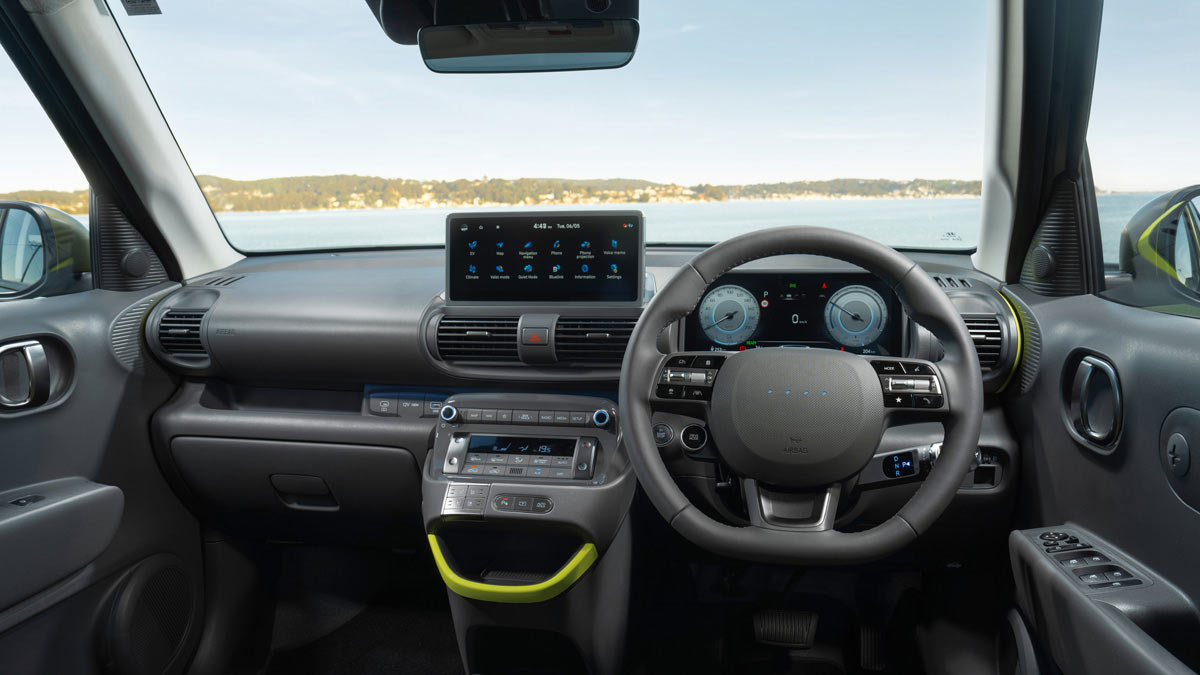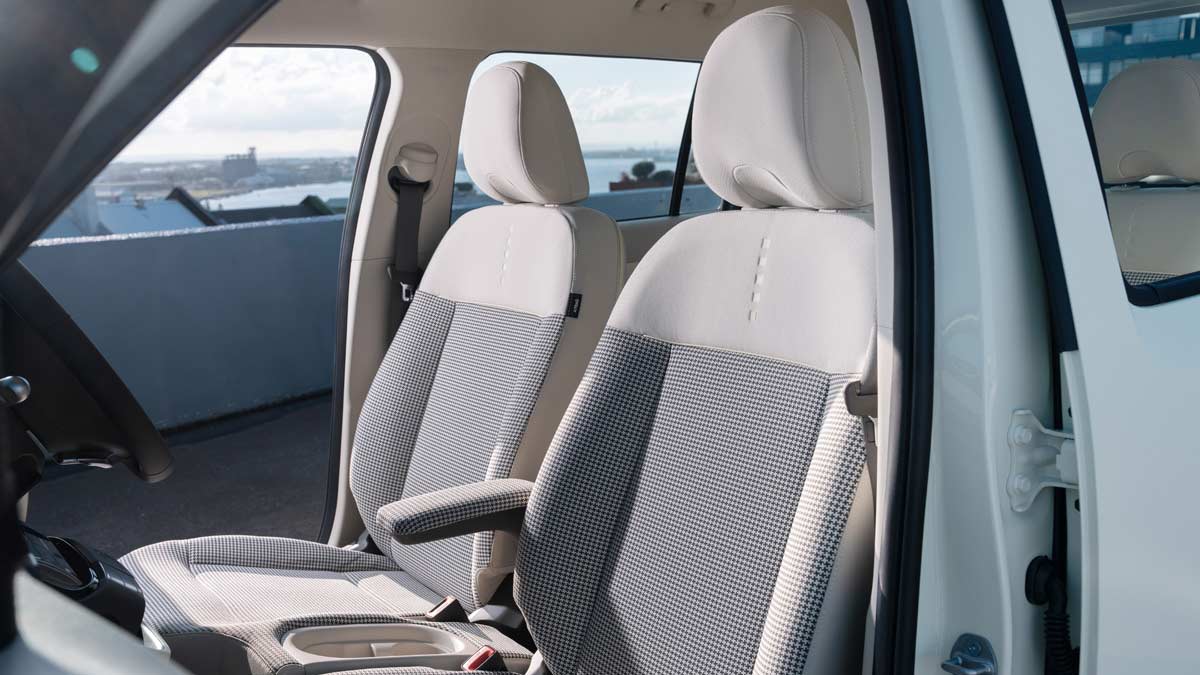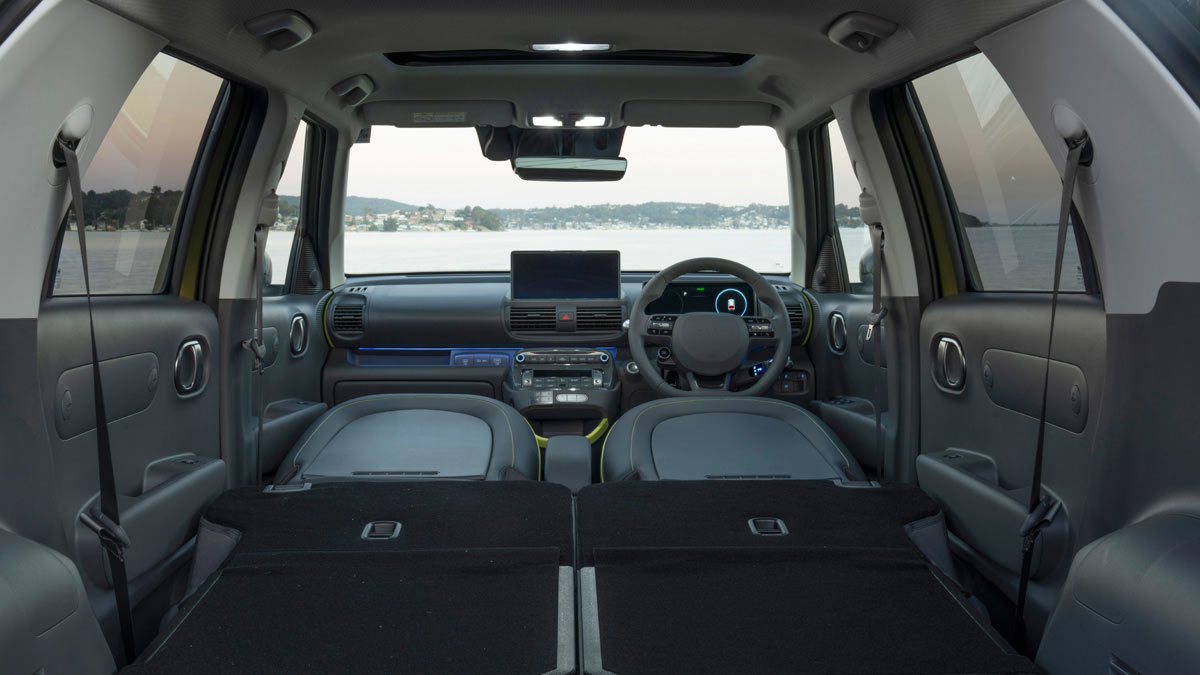You can now buy an EV for $25,000 and there’s a wide range of electric cars and SUVs for less than $45K from BYD, MG, GWM, Chery and other brands. Here are the cheapest EVs to buy in Australia right now.
2025 Hyundai Inster review
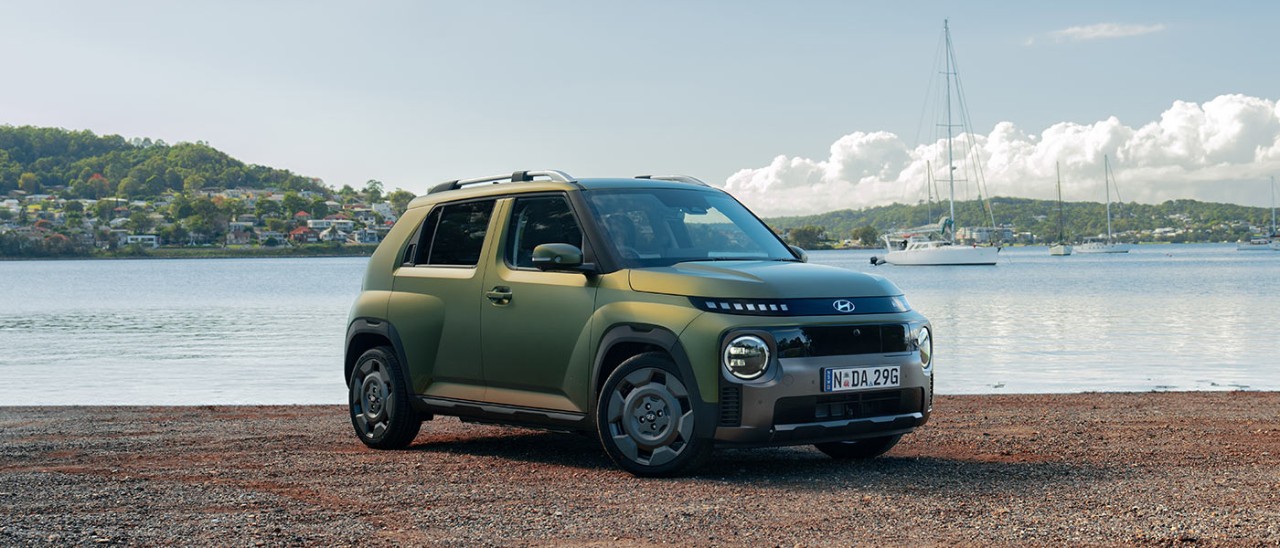
The smart little Hyundai Inster SUV has arrived in Australia, hot on the heels from winning World Electric Car of the Year. With a striking design and reasonable electric driving range up to 360km, the Hyundai Inster presents as an excellent EV option for urban drivers, empty nesters, or couples looking for an interesting and useful second vehicle.
While on the surface the pricing of the new 2025 Hyundai Inster appears ambitious when compared to the cheapest electric cars from China, this premium package makes a great deal of sense once behind the wheel.
The Hyundai Inster offers a mature driving feel, exudes quality and ticks a host of design-focused boxes for drivers looking for a zesty and small electric car that stands out from the pack. The diminutive Inster is easy to manoeuvre and refreshing to park against a sea of larger family SUVs and 4x4 utes.
The Inster also presents an impressive suite of technology that isn't intimidating to use, offering conventional interfaces and eschewing digital overload in favour of buttons, a touchscreen and voice control that just works.
On this page
How much does a 2025 Hyundai Inster cost?
The Hyundai Inster is now the most affordable electric car in the brand's expanding suite of electric cars in Australia. It undercuts the Hyundai Kona small SUV and arrives with a simple range comprising a standard range model, extended range model and then a range-topping Cross variant which adds styling and tech features.
The Hyundai Inster Standard Range model costs $39,000 plus on-road costs. It is fitted with a 42kWh battery which is claimed to be good for around 327km electric driving range (WLTP). It offers 71kW city focused power from the front axle motor and rides on a smaller 15-inch wheel which contributes to its frugal efficiency claim.
Hyundai says its most affordable model has an energy consumption figure of just 14.3kWh/100km (combined), making it one of the most efficient electric vehicles available in Australia.
The Hyundai Inster Extended range model and Cross variants are fitted with a larger 49kWh battery that generates 84kW from the motor. The larger battery promises electric driving range up to 360km (WLTP). The Extended Range model, which is differentiated from the standard range model by larger 17-inch wheels, is on sale for $42,500 plus on road costs.
Standard technology features across the Hyundai Inster range include dual 10.25-inch digital displays, Hyundai Bluelink Connected Car Services with a complimentary five-year subscription, and over-the-air updates for the onboard navigation system as well as Hyundai’s latest Smartsense safety suite. All vehicles are equipped with vehicle to load capability, including a 240V socket handily located at the front of the cabin.
The Hyundai Inster Cross is the pinnacle of the range and is available for $45,000 plus on-roads. It takes the specification of the Extended Range, swaps out the wheel for a different design, and adds either a sunroof, or a removable roof basket for extra load capacity. It also features the best level of driver assistance technology, adding a surround camera, blind-spot view monitor and front parking distance warning.
Capped price servicing is available across the Hyundai Inster range with an extended interval of 30,000kms or 24 months. If you choose to service at one of Hyundai’s 146 service centres expect to pay $655 for each of the first two visits.
Hyundai Australia is supporting the Inster with a 5-year, unlimited kilometre warranty on the vehicle and an eight-year/ 160,000km warranty on the propulsion battery.
Read more: The cheapest cars in Australia in 2025
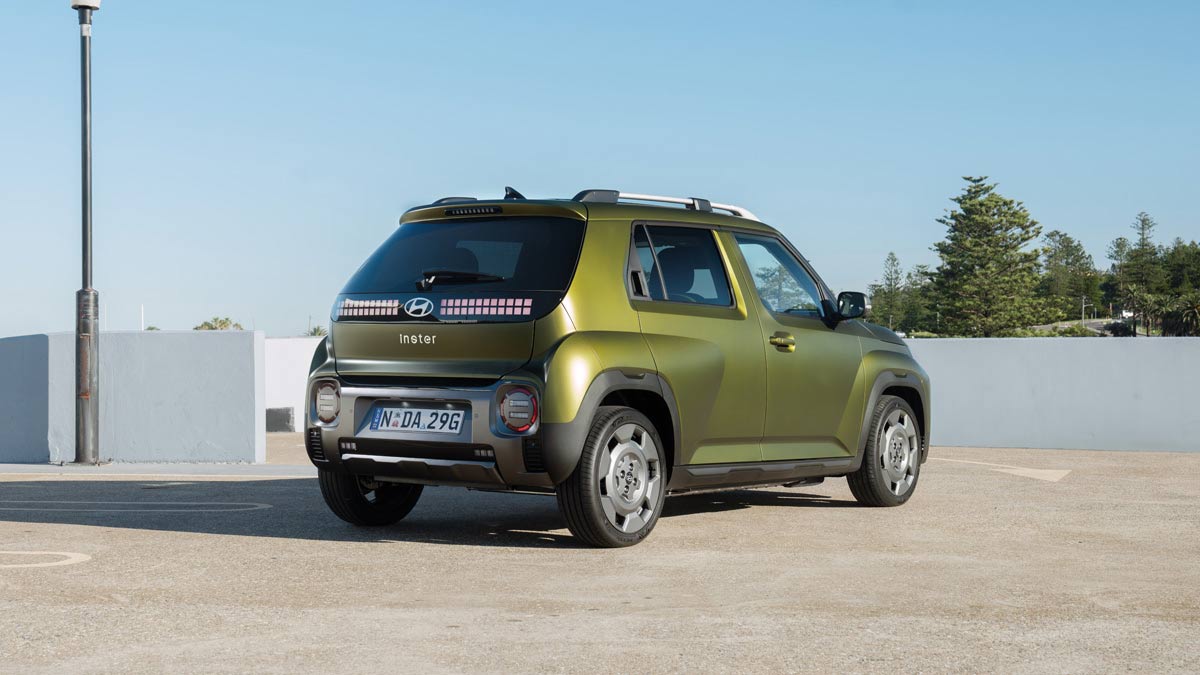
The Hyundai Inster has a unique look with digital pixel lighting
2025 Hyundai Inster exterior design
The Hyundai Inster is less than four metres long, which makes it smaller than the Hyundai Venue light SUV. It features a compact and distinctive design with round pixel LED headlamps, pixel-graphic turn signals, and what Hyundai describes as a 'muscular skid plate.'
The exterior design of the Inster is fun and funky, with its rear tail light treatment certainly standing out in traffic.
Available in nine colour options, including six which are new to the Hyundai portfolio, the Hyundai Inster is also offered with optional metallic and matte paint finishes. Expect to pay $595 for metallic options and $1000 for the matte finish. Buttercream yellow is the brand's hero colour, while Amazonas Green is available exclusively on Inster Cross models.
Buyers of the Hyundai Inster Cross can also further extend their styling and storage options with the addition of a roof basket in place of a sunroof. While this adds extra storage space and will carry an additional 75kg, this feature will have significant impact on range when fully laden, reducing the claimed range from 360km to 293km (WLTP). It can be removed by owners however when it's not in use.
What is the Hyundai Inster like inside?
The Hyundai Inster interior mirrors its funky exterior. Two interior options are offered on the Inster Standard Range, both featuring recycled PET upholstery. On Inster Cross models, two synthetic leather trims are offered. Both pairs of options offers a choice of a darker, more forgiving colourway or a brighter, more dynamic finish.
The cabin is highlighted with a 10.25-inch digital cluster and a 10.25-inch infotainment touchscreen with sat-nav included. Cars also feature Apple CarPlay and Android Auto integration - however it isn't wireless.
The Standard and Extended Range vehicles feature a clever bench-style front seat, which has the dual cupholder integrated into the edge of the driver's seat. The effect is a cosy environment for driver and front passenger. You'd better share your partner's preference for heating or cooling though, as this is one of the few vehicles on sale today not to offer dual-zone climate control.
The Inster's tight door pockets aren't large enough to stash anything more than a pamphlet. However, integrated storage cubbies feature throughout the centre console, with wireless charging available for one phone, and USB-A and USB-C charging options available for other devices. Up front is a 240V socket ideal for plugging in a laptop, while the passenger front seat has a hard back and folds flat so it can be used as a table for working on the go.
Stepping up to the Hyundai Inster Cross will add several creature comforts such as heated and ventilated front seats, heated steering wheel and ambient lighting. The likeable bench-style front seat is swapped out for two 50:50 front seats, however.
The Hyundai Inster also comes into its own when it comes to the sliding rear seats which are standard across the range. The Inster's boot space is just 280 litres, which is tight for two overnight bags plus a couple of handbags, though both rear seats can slide forward to expand the space to 351 litres.
In an SUV of this size, the rear seat room is tight. With the sliding seat forward and a six foot driver, an adult passenger is squashed. Pull the driver's seat forward and shift the rear seat back though and there's enough room to sit behind the driver in some level of comfort.
Boot space isn't compromised if the driver needs to carry bulky items. Both rear seats fold 50:50 and the front passenger and driver's seat fold flat too so there are various configurations of space available to move things around in the Inster. With all seats folded, there's even room for a small mattress to lie across all of them.
Is the Hyundai Inster good to drive?
In essence, the Hyundai Inster is a fun car to drive. While it shines in the urban environment, it is surprisingly enjoyable on open and regional roads.
Hyundai Australia was able to select the best suspension hardware for the local specification of the Inster, and the result is a car that is responsive and rides bumps well. This is no doubt aided by the use of small rims and tyres which are much more forgiving than the larger packages favoured by larger SUVs.
Four drive modes are available in the Inster including Eco, Normal, Sport and Snow. Three levels of regenerative braking are available with levels able to be altered by using the paddle shifters. Driving efficiency on first impression is encouraging; a 50km drive out of Sydney saw the standard range vehicle display 11kWh/100km, well ahead of the claimed WLTP range. This result makes sense - the Inster is light (by EV standards) as it doesn't carry around a big vehicle battery, or the extra vehicle bulk of a larger SUV.
When it comes to uphill driving, there's more power to be derived from the Extended Range or Cross models and you'll need to urge either model along on a steep gradient. However, the Inster doesn't feel like it struggles.
Significant efforts were made by the Hyundai engineering team to reduce noise intrusion into the cabin, and it works. Forget your experience of light cars or compact SUVs of the past, the Hyundai Inster feels suitably robust and noise intrusion is minimal.
How safe is the Hyundai Inster?
The Hyundai Inster is currently untested by ANCAP or Euro NCAP. It's is equipped with a full suite of safety technology, shared with some of the larger vehicles in Hyundai's range. That means it still suffers from a series of audible alerts to indicate different traffic situations and its not always obvious what they relate to.
Listed technologies across the range include Intelligent Speed Limit Assist (ISLA) and Highway Driving Assist (HDA). Inster Cross also features additional systems including Blind-Spot View Monitor (BVM) and a Surround View Monitor (SVM).
Hyundai also includes a five year subscription to its connected services including eCall and breakdown assistance technology.
Noticeably, the Inster misses out on airbags for rear passengers and the curtain airbags only cover the front row. It's a concerning omission which may well impact a five-star testing result from ANCAP.
How does the Hyundai Inster compare?
It's pretty easy to compare the Hyundai Inster with the cheaper end of the EV market and think that other vehicles may offer greater value for money, but that's to ignore the fact that the Hyundai Inster presents as a premium product with solid tech integration and ride and handling compared to its rivals.
A good point of comparison for the Inster is the Chery E5. This is a vehicle which is significantly larger and is currently available from around $40,000 drive-away in Victoria. However, the E5 does not have the mature feel of the Hyundai Inster, so while on paper it might look like a better option, buyers that value driving refinement and enjoyment are likely to preference the Inster.
If you're just cross shopping small electric cars, then the closest competitors to the Inster are the BYD Dolphin, MG4 and GWM Ora.
With a bigger budget, buyers may wish to compare the Inster with the Peugeot e-2008, Fiat 500e and small petrol-hybrid SUVs like the Toyota Yaris Cross. They each offer buyers something different, whether it's style, packaging or drivetrain.
More: Search and compare cars with price guide and data insights
Should I buy a Hyundai Inster?
In this reviewer's eyes, the Hyundai Inster offers good value, even if it isn’t the cheapest vehicle for its size. It’s easily the best to drive and the best executed in its category, and it is supported by one of the largest dealer networks in the country and a comprehensive warranty.
The smaller battery size means the Hyundai Inster will charge quickly. Depending on which battery you choose, it will go from 10 per cent to 100 per cent charge in either four or four-and-a-half hours on a regular household socket, or within 30 minutes at up to 120kW.
While you can buy a bigger SUV for the price, consider whether the Inster is actually the right size for you and your household. Its small size makes it easy to live with and zip around town, and the Inster is a car that refreshingly goes against the grain that bigger equals better.
We'll reserve a wholehearted recommendation until an ANCAP score is announced.
The information provided is general advice only. Before making any decisions please consider your own circumstances and the Product Disclosure Statement and Target Market Determinations. For copies, visit racv.com.au. As distributor, RACV Insurance Services Pty Ltd AFS Licence No. 230039 receives commission for each policy sold or renewed. Product(s) issued by Insurance Manufacturers of Australia Pty Ltd ABN 93 004 208 084 AFS Licence No. 227678.
